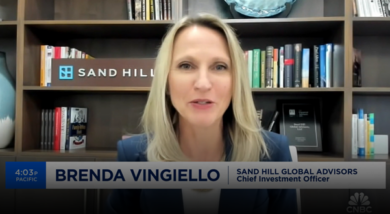Brenda Vingiello, Sand Hill's Chief Investment Officer, joined the Halftime Report to discuss the software space. This content was produced and provided by an unaffiliated

Pondering 2020 So Far
July 20, 2020
Pondering the year 2020 so far is exhausting, and probably a little disorienting too. Many adjectives could apply given the mixed and ever-changing messages with regard to just about everything, coming from everywhere. Financial markets have only added to this heightened level of confusion for most people as the stock market initially collapsed and then subsequently marched higher in the face of one of the worst recessions in history, as well as the greatest social unrest in a generation. And yet, when taking a step back to examine things, the market action is not as surprising as it may seem.
When shelter-in-place directives were put in place in March and economic activity abruptly slowed, it was clear that the economy would most likely end up in recession. Financial markets quickly reflected this, and the S&P 500 fell more than 30% in just a few short weeks. Then, in what seemed like the blink of an eye, it began to recover, and this recovery continued throughout the remainder of the second quarter until the S&P 500 was almost back to where it started the year. Is it possible that the negative market reaction could have been so fleeting?
When looking at previous recessions, the cause of any given economic slowdown has always been an important factor in determining how fast a recovery might be expected to take place. Slowdowns caused by the unwinding of economic excesses have often taken years to recover, while those caused by an event have typically experienced much faster recoveries. The initial COVID-19 pandemic impact occurred very quickly during just a few weeks and the severity of the resulting economic slowdown will probably end up being the worst in modern times. However, the economy was quite healthy when it began, making it hard to argue that this has been anything other than an event-driven recession. Historically, stock markets have bottomed when economic news and uncertainty have been at their worst, and that point seems to have coincided with the market bottom in late March. At that time, little was still known about how COVID-19 spread and who was the most vulnerable, and as millions of people were being furloughed or losing their jobs, schools were closing, and no one knew what more might happen next. Our view that this was an event-driven recession, albeit a very severe one, helped guide our basic underlying decision to step in when uncertainty was high and add to equity exposure during March and early April; and these investments significantly contributed to overall returns during the quarter.
Even though we are likely past the peak in uncertainty, there potentially will still be economic fallout in the form of bankruptcies and permanent business closures. Yet, many businesses are beginning to reopen as quickly as they closed, and this certainly is not characteristic of a typical recession. We have been surprised, and so have financial markets, by the magnitude of the economic recovery that began to play out in May and June. Forward-looking measures of business activity in both the services and manufacturing industries jumped from historically low levels in April to outright expansion, and this was accompanied by surprise job growth. Of course, this type of recovery would not have been possible without the economic stimulus measures implemented in record time by both the Federal Reserve and the Federal government. Still, the pace of recovery has so far been a positive surprise, and this has helped support financial markets’ move higher.
We have also seen that some industries have experienced little negative impact thus far. In a traditional recession, economic pain would be more widely felt across most industries, but this has not been the case this time. In fact, many businesses, particularly those in the technology sector, did not shut down at all and, after the initial disruption of learning to almost completely operate in remote work environments, many are now realizing that allowing employees to work at home more often could permanently help reduce costs. This reality has been reflected in financial markets where the relatively healthy technology, communications and healthcare sectors, which now comprise more than 50% of the S&P 500, have been responsible for the majority of the stock market rise since late March. Other, more economically sensitive, sectors are still down considerably for the year, which is not surprising given the weaker fundamentals in these parts of the economy.
As we look forward, there are several factors that could contribute to further volatility in economic trends and financial markets. A recent rise in COVID-19 infections is likely to be handled on a regional basis but could still contribute to the overall economic recovery stalling before recovering further. The upcoming presidential election may also contribute to volatility. Nonetheless, we cannot ignore the significant effort, much of it behind the scenes, being put into finding an effective vaccine or therapy. Several human trials are happening this summer and any positive developments and news could enable the more economically sensitive and struggling sectors of the market to recover more meaningfully. There is also a significant amount of cash still sitting on the sidelines, which is a direct function of the unique type of uncertainty that this pandemic generates. We expect that much of this cash will eventually find its way back into the equity market over time, especially since interest rates across the Treasury yield curve are so low; indeed, these rates are less than the rate of inflation, making cash and Treasury bonds an unattractive long-term holding.
In our view, the rather prevalent perception that recent stock market action is divorced from reality is somewhat unfair. Financial markets are forward looking, and we have mostly moved past the period of peak uncertainty, and the economy is improving at a faster-than-expected pace. If nothing else, this year has so far provided a strong reminder that even during periods of great uncertainty and ever-changing messages and information, a disciplined investment strategy is key, as is the conviction to stick with it and constantly monitor and rebalance. In keeping with this sensible approach, we also trimmed back equity exposure late in the second quarter following the 20% rebound that the S&P 500 experienced. We remain confident that financial markets can deliver positive returns from current levels, but also recognize the importance of actively managing overall levels of risk, too.
Articles and Commentary
Information provided in written articles are for informational purposes only and should not be considered investment advice. There is a risk of loss from investments in securities, including the risk of loss of principal. The information contained herein reflects Sand Hill Global Advisors' (“SHGA”) views as of the date of publication. Such views are subject to change at any time without notice due to changes in market or economic conditions and may not necessarily come to pass. SHGA does not provide tax or legal advice. To the extent that any material herein concerns tax or legal matters, such information is not intended to be solely relied upon nor used for the purpose of making tax and/or legal decisions without first seeking independent advice from a tax and/or legal professional. SHGA has obtained the information provided herein from various third party sources believed to be reliable but such information is not guaranteed. Certain links in this site connect to other websites maintained by third parties over whom SHGA has no control. SHGA makes no representations as to the accuracy or any other aspect of information contained in other Web Sites. Any forward looking statements or forecasts are based on assumptions and actual results are expected to vary from any such statements or forecasts. No reliance should be placed on any such statements or forecasts when making any investment decision. SHGA is not responsible for the consequences of any decisions or actions taken as a result of information provided in this presentation and does not warrant or guarantee the accuracy or completeness of this information. No part of this material may be (i) copied, photocopied, or duplicated in any form, by any means, or (ii) redistributed without the prior written consent of SHGA.
Video Presentations
All video presentations discuss certain investment products and/or securities and are being provided for informational purposes only, and should not be considered, and is not, investment, financial planning, tax or legal advice; nor is it a recommendation to buy or sell any securities. Investing in securities involves varying degrees of risk, and there can be no assurance that any specific investment will be profitable or suitable for a particular client’s financial situation or risk tolerance. Past performance is not a guarantee of future returns. Individual performance results will vary. The opinions expressed in the video reflect Sand Hill Global Advisor’s (“SHGA”) or Brenda Vingiello’s (as applicable) views as of the date of the video. Such views are subject to change at any point without notice. Any comments, opinions, or recommendations made by any host or other guest not affiliated with SHGA in this video do not necessarily reflect the views of SHGA, and non-SHGA persons appearing in this video do not fall under the supervisory purview of SHGA. You should not treat any opinion expressed by SHGA or Ms. Vingiello as a specific inducement to make a particular investment or follow a particular strategy, but only as an expression of general opinion. Nothing presented herein is or is intended to constitute investment advice, and no investment decision should be made based solely on any information provided on this video. There is a risk of loss from an investment in securities, including the risk of loss of principal. Neither SHGA nor Ms. Vingiello guarantees any specific outcome or profit. Any forward-looking statements or forecasts contained in the video are based on assumptions and actual results may vary from any such statements or forecasts. SHGA or one of its employees may have a position in the securities discussed and may purchase or sell such securities from time to time. Some of the information in this video has been obtained from third party sources. While SHGA believes such third-party information is reliable, SHGA does not guarantee its accuracy, timeliness or completeness. SHGA encourages you to consult with a professional financial advisor prior to making any investment decision.







